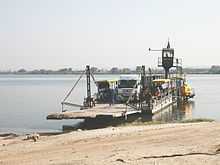Kazungula Ferry

The Kazungula Ferry is a pontoon ferry across the 400-metre-wide Zambezi River between Botswana and Zambia. It is one of the largest ferries in south-central Africa, having a capacity of 70 tonnes. The service is provided by two motorised pontoons and operates between border posts at Kazungula, Zambia and Kazungula, Botswana.[1]
It links the Livingstone-Sesheke road (which connects to the Trans–Caprivi Highway at Katima Mulilo and forms part of the Walvis Bay Corridor) to the main north-south highway of Botswana through Francistown and Gaborone to South Africa, and also to the Kasane-Victoria Falls road through Zimbabwe. It serves the international road traffic of three countries directly (Zambia, Zimbabwe and Botswana) and of three more indirectly (Namibia, South Africa and DR Congo).[2]
In 2003 the ferry was the site of a disaster when a severely overloaded Zambian truck capsized one of the pontoons and 18 people drowned. The accident was blamed on the lack of weighbridges in Zambia to check the weight of trucks.[3]
At Kazungula the territories of four countries (Zambia, Botswana, Zimbabwe, and Namibia) come close to meeting at a quadripoint. It has now been agreed that the international boundaries contain two tripoints joined by a short line roughly 150 meters long forming a boundary between Zambia and Botswana across which the ferry can, in principle, travel without entering either of the other two countries. The ever-shifting river channels and the lack of any known agreements addressing the issue before year 2000, led to some uncertainty in the past as to whether or not a quadripoint legally existed.[4][5]
In August 2007 the governments of Zambia and Botswana announced a deal to construct a bridge at the site to replace the ferry.[6] The existence of a short boundary of about 150 meters between Zambia and Botswana was apparently agreed to during various meetings involving heads of state and/or officials from all four states in the 2006-10 period and is clearly shown in the African Development Fund project map,[7] matching the US Department of State Office of the Geographer depiction in Google Earth. The planned route for the new bridge crosses this boundary without entering Zimbabwe or Namibia.
Zimbabwe already has a bridge with Zambia at Victoria Falls, 70km from Kazungula. Namibia already has a crossing with Zambia at Katima Mulilo about 150km upriver. For those travelling from South Africa to Zambia's copperbelt or Lusaka by road, routes through Zimbabwe are several hundred kilometres shorter.
References
- ↑ Camerapix: "Spectrum Guide to Zambia." Camerapix International Publishing, Nairobi, 1996.
- ↑ Terracarta/International Travel Maps, Vancouver Canada: "Zambia, 2nd edition", 2000.
- ↑ Times of Zambia website "Stiffer law against overloading ready" 7 February, 2007, accessed 1 March 2007.
- ↑ Brownlie, Ian; Ian R. Burns (1979). "Botswana-Zambia (Quadripoint issue)". African Boundaries: A Legal and Diplomatic Encyclopaedia. London: C. Hurst & Co. pp. 1098–1108. ISBN 0-903983-87-7. ; summarized at African tripoints: Botswana-Namibia-Zambia by Michael Donner / Jesper Nielsen.
- ↑ Akweenda, S. (1997-04-23). "VI: Quadripoint Theory". International Law and the Protection of Namibia's Territorial Integrity. Netherlands: Martinus Nijhoff. pp. 201–3. ISBN 90-411-0412-7.
- ↑ "Zambia and Botswana reach Kazungula bridge deal." Palapye News blog. Retrieved 12 November 2007.
- ↑ Darwa, P. Opoku (2011). Kazungula Bridge Project. African Development Fund. p. Appendix IV. Retrieved 2012-05-04.